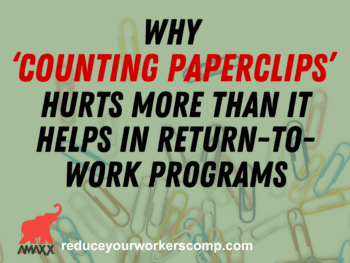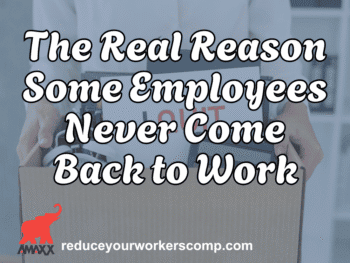Whether the cause of disability is work-related or not, maintain a strong RTW policy. Employees will soon call a lawyer if it looks like they will have to file for SSDB*. Those lawyers are good at spotting unfiled comp claims, as well as ADA or discrimination claims.
Key Communication Concepts:
1- Always maintain frequent (1 per week) and regular (Same time, same day) communications with employee. Breaking off communication means that whatever they think or believe may be a picture painted by someone you don’t know (a lawyer) and you will be that last to find out what the consequences will be.
2- Always hold out possibility of return to work.
3- Always offer to be the center of communications (with worker, doctor, carrier, workers’ comp board, group health, LTD, Soc Sec). Sounds difficult (it’s not) but prevents big problems from ever arising.
Workers’ comp and SSDB overlap: You can collect both. However, if comp and SSDB (monthly) exceed 80% of your Social Security “monthly wage” (incredibly difficult to compute) the excess is deducted from SSDB in some states, or from the work comp in others. There are cost of living benefit raises, if awarded by Congress in later years.
In work comp, total disability (with certain exceptions for the blind) means no work whatsoever can be performed. In SSDB, you can earn up to $300/month and still collect SSDB. (That is to encourage a return to a workplace. You can also return for a 9-month trial period at any higher salary.)
An example of non-occupational RTW in modified position: a young woman with totally disabling colitis was a brilliant young worker. No workers’ comp claim was filed in this example as it was a non-occupational illness. Her employer allowed her to work from home for six months before saying it was no longer an option.
Her manager no longer worked with employer, but our firm located him. He wrote the judge a full letter detailing the work from home situation because on the books it looked as though she was working normally. This letter resulted in $20,000 additional benefits and immediate Medicare coverage for a worker who was otherwise unable to work. Employer and manager never realized the significance of their participation although employer was a major city in southern CA.
Potential Benefits to the employer are:
(1) establishing objective evidence of wage earning capacity (sometimes this is in favor of the employer),
(2) compliance with ADA,
(3) employer assistance on a trial return to work period, can be used to defend against ADA claims since they document employer’s efforts to return disabled to work,
(4) engaging in a “work-hardening” effort which is most advantageous for rehab,
(5) less disruption of work flow (this worker was a highly specialized engineer involved in ongoing projects for which she could not easily be replaced),
(6) lower “demoralization downside”, resulting from lack of compassion for seriously injured member of workplace team.
Since she was a municipal employee there might have been benefits to the employer in her contract but these never surfaced. Had her condition improved slightly she would have returned to work. However, without the work from home all hope of any recovery would have been lost one year sooner. Instead she had a series of surgeries which ruled that out. With home work stations, many clerical positions can be done, part time at least, from home and this can make a big difference in returning these workers.
*Abbreviations:
SSDI means Social Security Disability Insurance.
SSDB means Social Security Disability Benefits.
SSI is Supplementary Security Income which are disability benefits for people w/o an earnings record. Low benefits and lawyers hardly ever get involved.
Attorney Theodore Ronca is a practicing lawyer from Aquebogue, NY. He is a frequent writer and speaker, and has represented employers in the areas of workers’ compensation, Social Security disability, employee disability plans and subrogation for over 30 years. Attorney Ronca can be reached at 631-722-2100.
Try the WC Cost Calculator to show the REAL COST of work comp.
Look at WC 101 for the basics about workers comp.
Workers’ Comp Kit® is a web-based online Assessment, Benchmarking and Cost Containment system for employers. It provides all the materials needed to reduce your costs significantly in 85% less time than if you designed a program from scratch.
Do not use this information without independent verification. All state laws are different. Consult with your corporate legal counsel before implementing any cost containment programs.
©2008 Amaxx Risk Solutions, Inc. All rights reserved under International Copyright Law. If you would like permission to reprint this material, contact Info@WorkersCompKit.com
















